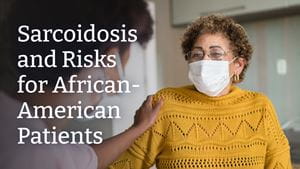
April marks Sarcoidosis Awareness Month, a time to ensure more people are mindful of the thousands of people who live with sarcoidosis on a daily basis.
While most people who live with sarcoidosis experience lung-related issues, this disease can affect other organs in the body and requires different methods of treatment.
Elizabeth Lee, MD, is an Advanced Heart Failure Cardiologist at the Sands-Constellation Heart Institute at Rochester Regional Health and treats patients who live with sarcoidosis affecting the heart.
Sarcoidosis (pronounced sar-coy-DOH-sis) is an inflammatory autoimmune disease. People living with sarcoidosis experience their immune system attacking itself and causing tiny pockets of inflammation – called granulomas – to appear.
These granulomas can occur anywhere in the body, but most often show up in the lungs. Approximately 90 percent of sarcoidosis patients have granuloma on their lungs, but it can also be found in other organs of the body, including:
Read more: After Heart Transplant, Patient Living New Life Outdoors
While an exact cause of sarcoidosis is not known, researchers are studying different factors that may influence its development.
Depending on the area of the body affected by sarcoidosis, there will be different symptoms on display.
For lung patients, symptoms may include
Heart patients may have symptoms such as
Patients with suspected sarcoidosis of the eyes may experience
Symptoms for patients with skin sarcoidosis may have
As previously stated, the exact cause of sarcoidosis requires further research. Scientists who are studying sarcoidosis have been able to determine that genetic and environmental triggers play some sort of role in how this disease develops.
Studying the combined impacts of genetics and environment is a key focus with sarcoidosis. Some of the elements that might be affect a patient’s overall health – and subsequently their sarcoidosis – include:
With regard to genetics, African-American patients are statistically more likely to live with sarcoidosis compared to other races or ethnicities, especially compared to white patients. They have a higher rate of being diagnosed compared to other races and ethnic groups, according to Dr. Lee. A 2015 study published in Chest found African-Americans were 12 times more likely to die of sarcoidosis compared to white patients.
“Across the spectrum of healthcare, we often find that non-white patients have worse health outcomes compared to white patients,” Dr. Lee said. “It is likely a variety of risk factors can have an effect on the development of sarcoidosis for various patients, so race should be taken into account as a potential factor.”
Since sarcoidosis is an autoimmune disorder, it can have periods of remission and periods when it flares up. Some patients will experience granulomas for short amounts of time that go away for months or years; other patients have granulomas that are a constant in their health.
The primary form of treatment for most patients is use of immunosuppressive medication to reduce the inflammation. Prednisone, a steroid, is primarily used by providers, while some will prescribe methotrexate, which is a non-steroid.
With some immunosuppressive medications, especially steroids, long-term use can sometimes lead to side effects, such as
If a patient isn’t responding to these medications and continues to have sarcoid-related inflammation, infusion treatments may be used. Trials for other methods of treatment are ongoing.
For Dr. Lee, forming a partnership with each patient, collaborating, and building a bond through the diagnosis and treatment process are the areas where she thrives. She takes a great deal of pride in determining the right course of action through what can be a difficult disease to treat.
“Because this is relatively rare, we take a careful approach,” Dr. Lee said. “If a patient suggests the possibility of sarcoidosis, providers are judicious about the process because there are a lot of things that can mimic sarcoidosis. Patients are living through a lot of tests and waiting, but we are going through the process because we care.”